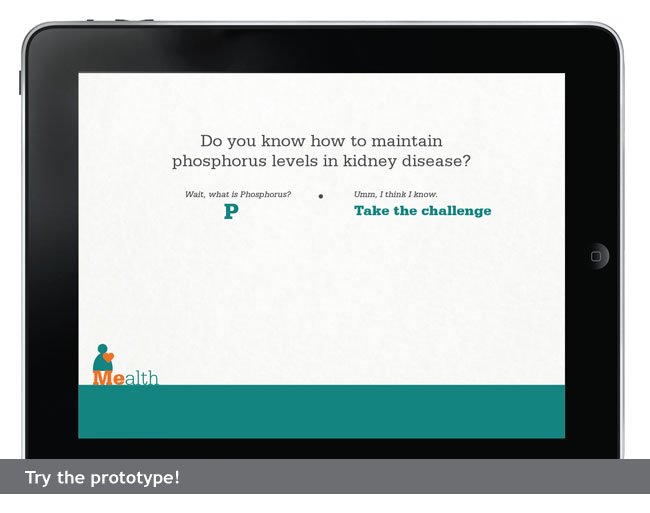 |
Resume |
njampala@andrew.cmu.edu |
|
MEALTH There is a current emphasis in the literature on the importance of facilitating adherence to medication in chronic illnesses. The research associated with nonadherence in ESRD identify three possible predictors: demographic, clinical and psychosocial. Across studies, psychosocial factors appear to be the most promising predictors of nonadherence, including patients’ understanding and beliefs about their treatment and their perceived social support. There is a need to develop an intervention to facilitate motivation, informed choice and appropriate adherence. In the current context, a doctor prescribes the medication to a patient without going into the details of the disease or the treatment. Based on the health insurance plan, the patient receives the medication from the pharmacist at a pharmacy. In most of the cases, the patient collects the medication and leaves the pharmacy with an understanding of how many tablets/day have to be taken. However, the patient doesn’t even realize the need and his/her right of counselling from a pharmacist. The only source of information that a patient receives is a package insert documenting the full prescribing information. Most of the information is either irrelevant or insufficient to address a particular patient. Additionally, the ESRD patients usually have more illnesses (e.g. diabetes, high blood pressure) and it’s difficult to follow the complexities of the treatment regimen. By developing a project that facilitates knowledge and adherence to phosphate binders in the form of an intervention, patients may become more motivate to adhere to medications that treat other chronic illnesses and answer some of the questions: How can patients understand and get aware of the complexities of their illnesses? How can patients have more control of their medications and treatment? How can we plan a clear procedure which will engage a patient to follow the complexities of the treatment regimen in a motivated and sustained way? The proposed project intervention is an interactive survey (game) facilitating the understanding to motivate patients to adhere to the recommended treatment. The intervention’s aim is to educate the patients about high phosphorus in body and the use of phosphate binders (how, when, effects, etc.) with a focus on importance of all three ways to reduce phosphate levels (diet, medication & dialysis). The interactive survey would be available as an ipad app which can be facilitated at the pharmacy while the patient is waiting to collect his/her medications or before an appointment at a clinic. The size of an ipad is appropriate for a patient to interact at a personal level in a public space. It would also be available on an online medical forum (e.g. davita.com) which can be used by a patient at his/her house. Prof. Stacie Rohrbach Information + Interaction + Perception, Fall 2012, Carnegie Mellon University |
Copyright © 2013 Somya Jampala. All Rights Reserved. |
